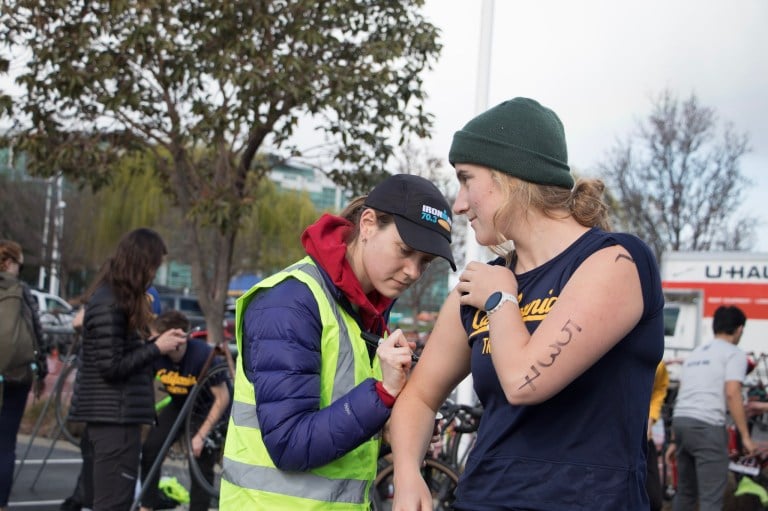While most students were sleeping in or taking in the California sunshine on Sunday morning, the Stanford Triathlon team got up early to host “Treeathlon,” their annual collegiate triathlon in Redwood City, Calif. 618 participants from schools across the West Coast took part.
For race organizers Sina Mollaei ʼ25 and Natalie Schieuer M.S. ʼ23, planning for the event started last summer.
“In June and July, we called over the summer and got some initial steps down and discussed what our visions were,” Mollaei said. “Once we got back on campus, like in September, that’s when we started doing monthly meetings with the sports office and got administrators involved. Then we got really, really consistent in January, February and March.”
“I think what helped us this year was that we had volunteers that did see the race prior,” Schieuer said, explaining that having an experienced organizing team proved valuable. “Moreover, this year we were able to leverage the knowledge of volunteers who did see the race before. We were also able to work with our volunteer coordinators to recruit more volunteers present on the race courses.”
Triathlons usually consist of three parts: a swim, a bike race and a run. These are all completed in succession, with no break in between. Treeathlon offers two types of races for its participants: the classic and draft-legal race. The major difference is that the draft-legal race allows the formation of bike packs, which helps decrease wind resistance and the amount of energy required to pedal. Moreover, each race has a plethora of divisions for different age groups and genders. While in a normal year, Treeathlon would comprise a 600-meter open-water swim, a 20-kilometer bike and a 5-kilometer run, weather conditions on Sunday proved untenable for the race’s planned swim portion.
“We follow USA Triathlon guidelines and we don’t want to risk the health of our participants,” Mollaei said. “It was below 54 or 53 degrees, and we didn’t want them to come out of the water and for it to be windy, so we made the call.” A USA Triathlon official ultimately ruled that the swim section would not go forward as planned.
Instead, entrants would complete a 0.7 mile run before hopping on their bikes. Aarnav Bahl, a competitor from Cal Poly, noted the difficulty of this sudden change. “I came here for a triathlon, but I did a duathlon,” Bahl said. “Running right before the bike felt kind of weird.”

Nate Wei, a competitor from UC Berkeley, expressed similar sentiments about the unforeseen change to the course. “I would say I’m more of a swimmer than a runner so I was starting off with my slowest leg,” Wei said.
Despite modifications to the original course, Treeathlon was a success for the team, raising money for future events while also providing an avenue for novices and seasoned athletes alike to compete.
“It’s a great way to contribute to the community,” Mollaei said. “There are people outside just collegiate athletes: there are age-group athletes, some who’ve been doing it for eight to ten years straight, and for others, this is their first triathlon.”
Mollaei also emphasized that Stanford Triathlon does not require any athletic background in order to compete in its events. “We don’t do any restrictions or tryouts,” Mollaei said. “I joined with no experience. If you want to join, we’ll work with you.”
A previous version of this article stated that organizers decided to cut the race’s swim portion due to weather conditions, when it was in fact a USA Triathlon official who ultimately made the call. The Daily regrets this error.
